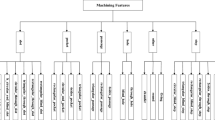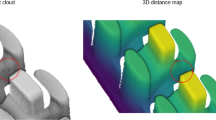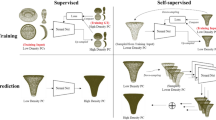Abstract
Surface classification is an effective way to assess the surface quality of parts. During the last decade, the assessment of parts quality has gradually changed from simple geometries to complex three-dimensional (3D) surfaces. Traditional quality assessment methods rely on identifying key product characteristics of parts, e.g., the profile of surface. However, for point cloud data obtained by high-definition metrology, traditional methods cannot make full use of the data and lose a lot of information. This paper proposes a systematic approach for classifying the quality of 3D surfaces based on point cloud data. Firstly, point clouds of different samples are registered to the same coordinate system by point cloud registration. Secondly, the point cloud is divided into several sub-regions by fuzzy clustering. Finally, a novel parallel classification network method based on deep learning is proposed to directly process point cloud data and classify 3D surfaces. The performance of the proposed method is evaluated through simulation and an actual case study of the combustion chamber surfaces of the engine cylinder heads. The results show that the proposed method can significantly improve the classification accuracy of 3D surfaces based on point cloud data.














Similar content being viewed by others
References
Choudhary, A. K., Harding, J. A., & Tiwari, M. K. (2008). Data mining in manufacturing: A review based on the kind of knowledge. Journal of Intelligent Manufacturing, 20(5), 501. https://doi.org/10.1007/s10845-008-0145-x
Colosimo, B. M., Mammarella, F., & Petrò, S. (2010). Quality control of manufactured surfaces. Frontiers in Statistical Quality Control, 9, 55–70.
Colosimo, B. M., Semeraro, Q., & Pacella, M. (2008). Statistical process control for geometric specifications: On the monitoring of roundness profiles. Journal of Quality Technology, 40(1), 1–18. https://doi.org/10.1080/00224065.2008.11917709
Di Angelo, L., & Di Stefano, P. (2015). Geometric segmentation of 3D scanned surfaces. Computer-Aided Design, 62, 44–56. https://doi.org/10.1016/j.cad.2014.09.006
Du, S., Liu, C., & Huang, D. (2015a). A shearlet-based separation method of 3D engineering surface using high definition metrology. Precision Engineering, 40, 55–73. https://doi.org/10.1016/j.precisioneng.2014.10.004
Du, S., Liu, C., & Xi, L. (2015b). A selective multiclass support vector machine ensemble classifier for engineering surface classification using high definition metrology. Journal of Manufacturing Science and Engineering, 137(1), 011003. https://doi.org/10.1115/1.4028165
Huang, D., Du, S., Li, G., Zhao, C., & Deng, Y. (2018). Detection and monitoring of defects on three-dimensional curved surfaces based on high-density point cloud data. Precision Engineering, 53, 79–95. https://doi.org/10.1016/j.precisioneng.2018.03.001
Jin, Y.-A., Li, H., He, Y., & Fu, J.-Z. (2015). Quantitative analysis of surface profile in fused deposition modelling. Additive Manufacturing, 8, 142–148. https://doi.org/10.1016/j.addma.2015.10.001
Laga, H., Guo, Y., Tabia, H., Fisher, R. B., & Bennamoun, M. (2019). Global shape descriptors. In 3D shape analysis (pp. 65–91). John Wiley & Sons, Ltd.
Lara López, G., Peña Pérez Negrón, A., Antonio Jiménez, A., Ramírez Rodríguez, J., & Imbert Paredes, R. (2017). Comparative analysis of shape descriptors for 3D objects. Multimedia Tools and Applications, 76(5), 6993–7040. https://doi.org/10.1007/s11042-016-3330-5
Li, X., Zhang, W., Ding, Q., & Sun, J.-Q. (2020). Intelligent rotating machinery fault diagnosis based on deep learning using data augmentation. Journal of Intelligent Manufacturing, 31(2), 433–452. https://doi.org/10.1007/s10845-018-1456-1
Maturana, D., & Scherer, S. (2015). VoxNet: A 3D convolutional neural network for real-time object recognition. In IEEE/RSJ international conference on intelligent robots and systems (IROS), 28 Sept–2 Oct 2015 (pp. 922–928). https://doi.org/10.1109/IROS.2015.7353481.
Ning, F., Shi, Y., Cai, M., & Xu, W. (2020). Various realization methods of machine-part classification based on deep learning. Journal of Intelligent Manufacturing, 31(8), 2019–2032. https://doi.org/10.1007/s10845-020-01550-9
Nurunnabi, A., Belton, D., & West, G. (2012). Robust segmentation in laser scanning 3D point cloud data. In International conference on digital image computing techniques and applications (DICTA), 3–5 Dec 2012 (pp. 1–8). https://doi.org/10.1109/DICTA.2012.6411672.
Osada, R., Funkhouser, T., Chazelle, B., & Dobkin, D. (2002). Shape distributions. ACM Transactions on Graphics, 21(4), 807–832. https://doi.org/10.1145/571647.571648
Qi, C. R., Su, H., Mo, K., & Guibas, L. J. (2016). PointNet: Deep learning on point sets for 3D classification and segmentation. In IEEE 2017 conference on computer vision and pattern recognition (CVPR), 21–26 July 2017 (pp. 652–660). arXiv:1612.00593.
Qi, C. R., Yi, L., Su, H., & Guibas, L. J. (2017). PointNet++: Deep hierarchical feature learning on point sets in a metric space. In 31nd Conference on neural information processing systems (NeurIPS), 4–9 Dec 2017 (pp. 5105–5114). arXiv:1706.02413.
Stankus, S. E., & Castillo-Villar, K. K. (2019). An improved multivariate generalised likelihood ratio control chart for the monitoring of point clouds from 3D laser scanners. International Journal of Production Research, 57(8), 2344–2355. https://doi.org/10.1080/00207543.2018.1518600
Su, H., Maji, S., Kalogerakis, E., & Learned-Miller, E. (2015). Multi-view convolutional neural networks for 3D shape recognition. In IEEE international conference on computer vision (ICCV), 13–16 Dec 2015 (pp. 945–953). https://doi.org/10.1109/ICCV.2015.114.
Syakur, M. A., Khotimah, B. K., Rochman, E., & Satoto, B. D. (2018). Integration k-means clustering method and elbow method for identification of the best customer profile cluster. IOP Conference Series: Materials Science and Engineering, 336, 012017. https://doi.org/10.1088/1757-899X/336/1/012017
Wang, A., Wang, K., & Tsung, F. (2014a). Statistical surface monitoring by spatial-structure modeling. Journal of Quality Technology, 46(4), 359–376. https://doi.org/10.1080/00224065.2014.11917977
Wang, K., & Tsung, F. (2005). Using profile monitoring techniques for a data-rich environment with huge sample size. Quality and Reliability Engineering International, 21(7), 677–688. https://doi.org/10.1002/qre.711
Wang, M., Xi, L., & Du, S. (2014b). 3D surface form error evaluation using high definition metrology. Precision Engineering, 38(1), 230–236. https://doi.org/10.1016/j.precisioneng.2013.08.008
Wells, L. J., Dastoorian, R., & Camelio, J. A. (2021). A novel NURBS surface approach to statistically monitor manufacturing processes with point cloud data (Report). Journal of Intelligent Manufacturing, 32(2), 329. https://doi.org/10.1007/s10845-020-01574-1
Wells, L., Megahed, F., Niziolek, C., Camelio, J., & Woodall, W. (2013). Statistical process monitoring approach for high-density point clouds. Journal of Intelligent Manufacturing, 24(6), 1267–1279. https://doi.org/10.1007/s10845-012-0665-2
Wu, Z., Song, S., Khosla, A., Yu, F., Zhang, L., Tang, X., et al. (2015). 3D ShapeNets: A deep representation for volumetric shapes. In IEEE conference on computer vision and pattern recognition (CVPR), 7–12 June 2015 (pp. 1912–1920). https://doi.org/10.1109/CVPR.2015.7298801.
Zang, Y., & Qiu, P. (2018a). Phase I monitoring of spatial surface data from 3D printing. Technometrics, 60(2), 169–180. https://doi.org/10.1080/00401706.2017.1321585
Zang, Y., & Qiu, P. (2018b). Phase II monitoring of free-form surfaces: An application to 3D printing. Journal of Quality Technology, 50(4), 379–390. https://doi.org/10.1080/00224065.2018.1508274
Zhang, L., Wang, K., & Chen, N. (2016). Monitoring wafers’ geometric quality using an additive Gaussian process model. IIE Transactions, 48(1), 1–15. https://doi.org/10.1080/0740817X.2015.1027455
Zhao, C., Du, S., Deng, Y., Li, G., & Huang, D. (2020). Circular and cylindrical profile monitoring considering spatial correlations. Journal of Manufacturing Systems, 54, 35–49. https://doi.org/10.1016/j.jmsy.2019.11.011
Acknowledgements
The authors greatly acknowledge the editor and the reviewers for their valuable comments and suggestions that have led to a substantial improvement of the paper. This work was supported by the National Natural Science Foundation of China (Grant No. 51775343) and the Shanghai Pujiang Program (Grant No. 18PJC031).
Author information
Authors and Affiliations
Corresponding author
Additional information
Publisher's Note
Springer Nature remains neutral with regard to jurisdictional claims in published maps and institutional affiliations.
Rights and permissions
About this article
Cite this article
Zhao, C., Du, S., Lv, J. et al. A novel parallel classification network for classifying three-dimensional surface with point cloud data. J Intell Manuf 34, 515–527 (2023). https://doi.org/10.1007/s10845-021-01802-2
Received:
Accepted:
Published:
Issue Date:
DOI: https://doi.org/10.1007/s10845-021-01802-2




